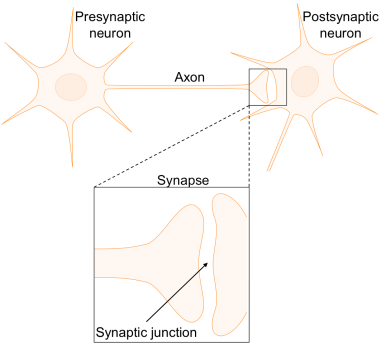March 21, 2018
By: Sarah Reitz
When you hear the word “moist”, do you shudder and grimace? There are certain words that seem to drive us crazy, perhaps because of how they sound or what they remind us of. But imagine that you found certain words aversive not because of how they sound, but because of how they taste! For people living with lexical-gustatory synesthesia, where language and taste are not independent of each other, this happens every day.
So what is this phenomenon that allows some people to quite literally eat their words? Synesthesia is a neurological condition of altered perception, and occurs when activation of one sensory or cognitive pathway leads to an involuntary activation of a second pathway. This means that there are many different types of synesthesia. For some synesthetes, or people with synesthesia, this means the association of sounds with different colors. Others may associate numbers with specific colors, or with a specific spatial location. While synesthesia can occur between nearly any two senses or cognitive processes, all types fall under two broad categories: projective synesthesia and associative synesthesia. Projective synesthetes will actually experience the sense associated with a stimulus, while associative synesthetes more often feel a strong connection between the stimulus and the specific sense. For example, a projective synesthete would actually see a bright yellow shape in their visual field when they hear a car horn, while an associative synesthete might hear the car horn and think that it “sounds” or “seems” yellow. Although associations may differ across types of synesthesia, for a single person these associations remain consistent across time. So the projective synesthete mentioned above will always see yellow when they hear a car horn, the “color” of a car horn to them will not change.

It has historically been difficult to determine the exact prevalence of synesthesia because of the many different forms it can take, as well as the spectrum of intensity experienced by different people. Researchers estimate that synesthesia might occur in anywhere from 1 in 200 to 1 in 20,000 people1. Chances are though, you have heard of at least a few famous synesthetes. Singer-songwriter Lorde has chromesthesia, or sound-to-color synesthesia, and Billy Joel, Nikola Tesla, and Duke Ellington are a few other well-known examples. People in creative professions are more likely to have synesthesia than the general population, perhaps because it provides a unique way of perceiving and creating art, music, or literature that leads to more synesthetes gravitating towards these careers. Ramin Djawadi, a composer who has created scores for Game of Thrones, Westworld, and Iron Man, associates colors and music. This promptly led me to spend 30 minutes wondering what exactly the Game of Thrones theme song might look like. I imagine it must be as dramatic as the music sounds!
Knowing that synesthesia involves some sort of perceptual crossing of paths between senses, one might imagine that there are differences between the brain of synesthetes and the general population. In fact, neuroimaging studies over the last 20 years support this idea. One study found increased gray matter, which is composed of of neuronal cell bodies, in an area called the superior posterior parietal lobe of synesthetes compared to non-synesthetes2. This was not altogether too surprising, since this region receives input from many sensory areas and may play a critical role in integrating different sensory experiences. Interestingly, temporarily inactivating this region via a technique called transcranial magnetic stimulation disrupts the synesthetic experience in grapheme-color synesthetes3. In addition to these neuroanatomical differences, other research suggests there may be enhanced connectivity in the brains of synesthetes. In one study, people with chromesthesia showed activation in the V4/V8 region of the visual cortex, an area referred to as the “color center”, after hearing spoken words4. As the name might suggest, this area is normally active when we are looking at colors, but not when we hear words. So what might be causing two distinct sensory regions of the brain to be activated by the same stimulus? The answer may have to do with brain connectivity.
Work published earlier this month from the Max Planck Institute for Psycholinguistics supports the hypothesis that enhanced connectivity between sensory centers in the brain may be the cause of synesthesia5. In this study, senior authors Dr. Simon Baron-Cohen and Simon E. Fisher led a team of researchers to identify potential genetic causes of sound-color synesthesia in 3 families with a history of this phenomenon. By analyzing DNA samples from multiple members of each family, they were able to identify 37 genes of interest that were altered in family members with synesthesia compared to those without. Interestingly, the genetic variants differed between synesthetes from different families, leading the researchers to wonder whether these variants might all be involved in a larger biological process (like brain connectivity!) that might explain how so many different genes can produce a similar phenomenon.
Sure enough, synesthetes in each family showed enhancements in genes that are involved in cell migration and axonogenesis and are first expressed during early childhood, when most synesthetes report first experiencing their symptoms. Axonogenesis is the process by which a neuron forms its axon, which is required for the neuron to connect to and communicate with other neurons in the brain. Each neuron has a single axon, which extends outward from the cell body and travels until it connects with the cell body of a different neuron, its postsynaptic partner (Figure 2).

This synaptic connection of an axon onto another cell is the basis of how neurons are able to communicate with each other, and is the most basic form of brain connectivity. You can probably tell where this is going, right? In people with enhanced axonogenesis, you can think of their neuronal connectivity being turned up to 11. Neurons are able to form connections with each other more strongly and more efficiently, leading to enhanced connectivity across the brain. While the idea of hyperconnectivity between brain regions as a cause of synesthesia is not a novel idea in the field, these results move past the neuroimaging studies and provide some of the first molecular evidence in support of this hypothesis.
For a long time, synesthesia was not viewed as a legitimate neurological condition, but rather as a case of an overactive imagination. However, thanks to the work of these scientists and many others, neuroscience is getting closer and closer to understanding the biological causes of this fascinating phenomenon. With continued research, we might one day be able to understand whether separate mechanisms are involved in different types of synesthesia, what causes different sensory centers to be hyperconnected in each type of synesthesia, or whether it might be possible to simulate synesthesia in those of us with normal axonogenesis. Until then, I’ll just have to wait for someone with chromesthesia to tell me exactly what the Game of Thrones theme song looks like.
Sources:
- Simner J et al. Synaestesia: the prevalence of atypical cross-modal experiences. Perception 2006;35(8): 1024-1033
- Rouw R, Scholte HS. Neural basis of individual differences in synesthetic experiences. J Neurosci. 2010;30(18):6205-6213
- Muggleton N, Tsakanikos E, Walsh V, Ward J. Disruption of synaesthesia following TMS of the right posterior parietal cortex. Neuropsychologia 2007;45(7):1582-1585
- Nunn JA et al. Functional magnetic resonance imaging of synesthesia: activation of V4/V8 by spoken words. Nat Neurosci. 2002;5(4):371-375
- Tilot AK et al. Rare variants in axonogenesis genes connect three families with sound-color synesthesia. Proc Natl Acad Sci 2018
Images:
Cover Image: Image by WillisGMiller. CC BY-SA 4.0 https://commons.wikimedia.org/wiki/File:Colormusik_Digital_Detail.png

Hello, my name is Carol Gordon and I have had many completely different experiences of what may be a different type of synesthesia. I do not conger them up, they just happen on their own and appear in front of me along with being able to see my surroundings clearly and, at the same time, a completely different scene overlaid as if hanging in the air in front of me. These have all come to me with a very clear message of import of what the projection means. In my reading many examples of synesthesia, they are all very color, number, taste etc. but have found very little of the projection in mid air type. Would like some info. on my type of experiences of the projuction types. Thank you.
LikeLike